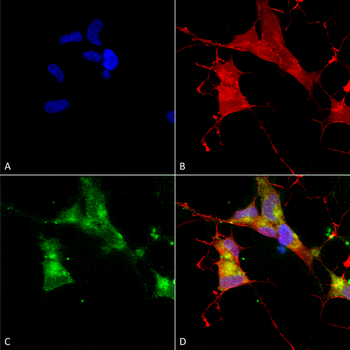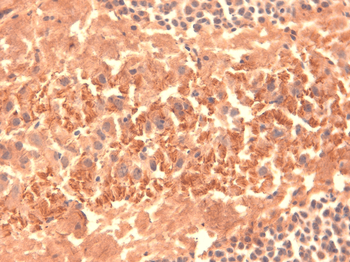You have no items in your shopping cart.
HCN4 Antibody: APC
Catalog Number: orb148500
| Catalog Number | orb148500 |
|---|---|
| Category | Antibodies |
| Description | Mouse monoclonal to HCN4 (APC). Ion channels are integral membrane proteins that help establish and control the small voltage gradient across the plasma membrane of living cells by allowing the flow of ions down their electrochemical gradient. They are present in the membranes that surround all biological cells because their main function is to regulate the flow of ions across this membrane. Whereas some ion channels permit the passage of ions based on charge, others conduct based on a ionic species, such as sodium or potassium. Furthermore, in some ion channels, the passage is governed by a gate which is controlled by chemical or electrical signals, temperature, or mechanical forces. There are a few main classifications of gated ion channels. There are voltage- gated ion channels, ligand- gated, other gating systems and finally those that are classified differently, having more exotic characteristics. The first are voltage- gated ion channels which open and close in response to membrane potential. These are then separated into sodium, calcium, potassium, proton, transient receptor, and cyclic nucleotide-gated channels; each of which is responsible for a unique role. Ligand-gated ion channels are also known as ionotropic receptors, and they open in response to specific ligand molecules binding to the extracellular domain of the receptor protein. The other gated classifications include activation and inactivation by second messengers, inward-rectifier potassium channels, calcium-activated potassium channels, two-pore-domain potassium channels, light-gated channels, mechano-sensitive ion channels and cyclic nucleotide-gated channels. Finally, the other classifications are based on less normal characteristics such as two-pore channels, and transient receptor potential channels. Specifically, hyperpolarization-activated cation channels of the HCN gene family contribute to spontaneous rhythmic activity in both the heart and brain. |
| Target | HCN4 |
| Clonality | Monoclonal |
| Species/Host | Mouse |
| Isotype | IgG1 |
| Conjugation | APC |
| Reactivity | Human, Mouse, Rabbit, Rat |
| Concentration | 1 mg/ml |
| Buffer/Preservatives | 95.64mM Phosphate, 2.48mM MES and 2mM EDTA |
| Purification | Protein G Purified |
| Immunogen | Fusion protein amino acids 1019-1198 (c-terminus) of rat HCN4 |
| UniProt ID | Q9JKA7 |
| MW | 130kDa |
| Tested applications | ICC, IF, IHC |
| Dilution range | WB (1:1000), IHC (1:1000), ICC/IF (1:100) |
| Application notes | 1 µg/ml of SMC-320 was sufficient for detection of HCN4 in 10 µg of COS cell lysate transiently transfected with HCN4 by colorimetric immunoblot analysis using Goat anti-mouse IgG:HRP as the secondary antibody. |
| Clone Number | N114/10 (Formerly sold as S114-10) |
| Storage | Conjugated antibodies should be stored according to the product label |
| Alternative names | Hyperpolarization activated cyclic nucleotide gate Read more... |
| Research Area | Cardiovascular Research, Neuroscience, Pharmacolog Read more... |
| Note | For research use only |
| Entrez | 59266 |
| NCBI | NP_067690.1 |
| Expiration Date | 12 months from date of receipt. |

Immunocytochemistry/Immunofluorescence analysis using Mouse Anti-HCN4 Monoclonal Antibody, Clone N114/10. Tissue: Neuroblastoma cells (SH-SY5Y). Species: Human. Fixation: 4% PFA for 15 min. Primary Antibody: Mouse Anti-HCN4 Monoclonal Antibody at 1:100 for overnight at 4°C with slow rocking. Secondary Antibody: AlexaFluor 488 at 1:1000 for 1 hour at RT. Counterstain: Phalloidin-iFluor 647 (red) F-Actin stain; Hoechst (blue) nuclear stain at 1:800, 1.6mM for 20 min at RT. (A) Hoechst (blue) nuclear stain. (B) Phalloidin-iFluor 647 (red) F-Actin stain. (C) HCN4 Antibody (D) Composite.

Immunohistochemistry analysis using Mouse Anti-HCN4 Monoclonal Antibody, Clone N114/10. Tissue: frozen brain section. Species: Mouse. Fixation: 10% Formalin Solution for 12-24 hours at RT. Primary Antibody: Mouse Anti-HCN4 Monoclonal Antibody at 1:1000 for 1 hour at RT. Secondary Antibody: HRP/DAB Detection System: Biotinylated Goat Anti-Mouse, Streptavidin Peroxidase, DAB Chromogen (brown) for 30 minutes at RT. Counterstain: Mayer Hematoxylin (purple/blue) nuclear stain at 250-500 μl for 5 minutes at RT.

Western Blot analysis of Human T-HEK cell lysate showing detection of HCN4 protein using Mouse Anti-HCN4 Monoclonal Antibody, Clone N114/10. Load: 15 μg. Block: 1.5% BSA for 30 minutes at RT. Primary Antibody: Mouse Anti-HCN4 Monoclonal Antibody at 1:1000 for 2 hours at RT. Secondary Antibody: Sheep Anti-Mouse IgG: HRP for 1 hour at RT.

Immunohistochemistry analysis using Mouse Anti-HCN4 Monoclonal Antibody, Clone N114/10. Tissue: hippocampus. Species: Human. Fixation: Bouin's Fixative and paraffin-embedded. Primary Antibody: Mouse Anti-HCN4 Monoclonal Antibody at 1:100 for 1 hour at RT. Secondary Antibody: FITC Goat Anti-Mouse (green) at 1:50 for 1 hour at RT.
HCN4 Rabbit Polyclonal Antibody (APC) [orb994974]
FC, IF
Bovine, Porcine, Rabbit
Human, Mouse, Rat
Rabbit
Polyclonal
APC
100 μlHCN4 Rabbit Polyclonal Antibody (APC-Cy7) [orb1813925]
FC, IF
Bovine, Porcine, Rabbit
Human, Mouse, Rat
Rabbit
Polyclonal
APC/Cy7
100 μlHCN4 Rabbit Polyclonal Antibody (APC-Cy5.5) [orb1813926]
FC, IF
Bovine, Porcine, Rabbit
Human, Mouse, Rat
Rabbit
Polyclonal
APC/Cy5.5
100 μl
HCN4 Antibody: APC (orb148500)
Participating in our Biorbyt product reviews program enables you to support fellow scientists by sharing your firsthand experience with our products.
Login to Submit a Review


